
Originally published in The Clarinet 51/4 (September 2024).
Copies of The Clarinet are available for ICA members.
Audio Reviews:
September 2024
RECORDINGS
 Vignettes. Salon Trio: Robert DiLutis, clarinet; Noah Getz, saxophone; Ying-Shan Su, piano. W.G. Still/arr. Salon Trio: Vignettes; Folk Suite No. 3; W.G. Still: Romance for alto saxophone and piano; W.G. Still/arr. Sharretts: Selections from the Lyric Suite; S. Coleridge-Taylor/arr. Salon Trio: Trio in E Moll; Five Negro Melodies for Piano Trio, op. 59. RM Records, RM010. Total Time: 62:00.
Vignettes. Salon Trio: Robert DiLutis, clarinet; Noah Getz, saxophone; Ying-Shan Su, piano. W.G. Still/arr. Salon Trio: Vignettes; Folk Suite No. 3; W.G. Still: Romance for alto saxophone and piano; W.G. Still/arr. Sharretts: Selections from the Lyric Suite; S. Coleridge-Taylor/arr. Salon Trio: Trio in E Moll; Five Negro Melodies for Piano Trio, op. 59. RM Records, RM010. Total Time: 62:00.
Vignettes by the Salon Trio (Robert DiLutis, clarinet, Noah Getz, saxophone, and Ying-Shan Su, piano) presents chamber pieces that expand the clarinet’s repertoire in important ways. This recording provides listeners with some wonderful original compositions and transcriptions of works for clarinet, saxophone, and piano written by historical black composers. Focusing on the works of William Grant Still and Samuel Coleridge Taylor, the album’s program displays a wide variety of characters and moods, from light and joyful to deeply profound. Additionally, chamber music for clarinet and saxophone is uncommon despite being a combination that works quite well together. This album is a pleasure for the listener, and the performances are of the highest quality.
Originally written for oboe, bassoon, and piano, the album’s title work Vignettes by William Grant Still is a mixture of lighthearted dance movements and Still’s signature lyrical writing. One is immediately struck by how well DiLutis and Getz blend as an ensemble, together with Su’s clean, expressive playing. This piece and Folk Suite No. 3 (originally for flute, oboe, bassoon, and piano) are the ensemble’s own transcriptions, and they work beautifully as if they had been originally written for this ensemble. The trio’s playing and careful arrangements bring out both the poignancy and jovial nature of Still’s character pieces.
The duo playing on this album is also excellent. Getz and Su perform Still’s Romance for alto saxophone and piano with great depth of emotion. Selections from the Lyric Suite (arr. Sharretts) is a lovely arrangement of one of Still’s string quartets intended for either clarinet or saxophone and piano. DiLutis plays with a singing, rich tone and the third movement, “The Jovial One,” is a delightfully spirited performance.
The album’s last two selections are arrangements of piano trios by Samuel Coleridge-Taylor. They are much larger and more complex than the Still compositions, and once again the arrangements are well-suited for a clarinet, saxophone, and piano trio. The Trio in E Moll is a particularly challenging technical tour de force for all three performers, and they play with great skill, polish, and determination. The clarinet and saxophone articulation in the finale is dazzling. The album’s last work, Five Negro Melodies for Piano Trio, op. 59, is a collection of richly expressive settings of traditional African American spirituals. Coleridge-Taylor’s music is sometimes compared to Mahler, and both trios are grand examples of late Romantic style.
I highly recommend seeking out this unique recording. The Salon Trio performs with great virtuosity and passion, from the cheerful and pleasant to the most turbulent and dark. Their transcriptions are outstanding, providing rare late-Romantic-style repertoire to perform with our saxophone colleagues. It is also exciting to see chamber music repertoire expanding to include underrepresented composers who were largely overlooked during their lifetime.
– Amanda McCandless
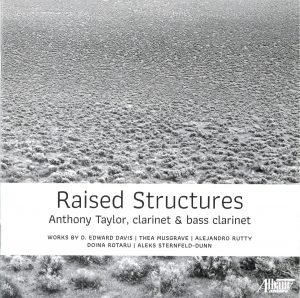 Raised Structures. Anthony Taylor, clarinet and bass clarinet, with Kelly Burke, clarinet. D.E. Davis: Raised Structures; T. Musgrave: Narcissus; A. Rutty: Guitars; D. Rotaru: Metamorphosis; A. Sternfeld-Dunn: 100 Years Later. Albany Records, TROY 1946. Total Time: 64:30.
Raised Structures. Anthony Taylor, clarinet and bass clarinet, with Kelly Burke, clarinet. D.E. Davis: Raised Structures; T. Musgrave: Narcissus; A. Rutty: Guitars; D. Rotaru: Metamorphosis; A. Sternfeld-Dunn: 100 Years Later. Albany Records, TROY 1946. Total Time: 64:30.
Coming in at just over an hour of music, Raised Structures is an excellent audio primer for those not familiar with the variety of sounds possible when performing with electronics. Anthony Taylor does an excellent job of playing with electronics as a dynamic part of the music, rather than an effect. This album contains works by D. Edward Davis, Thea Musgrave, Alejandro Rutty, Doina Rotaru, and Aleks Sternfeld-Dunn. It is refreshing to hear such a diverse album of living composers.
In the title track, Raised Structures by D. Edward Davis, Taylor plays both BÌ and bass clarinet parts with ease. Throughout this album, his bass clarinet prowess is on display. Very minimalist in nature, but effective, the work begins with a constant air sound in the background. Sound suddenly cuts out to a group of clarinet parts all very actively trilling. This oscillates between moments of little movements based in timbral variation and more active moments. Behind or between these sections are electronic sounds similar to air and water. Taylor works with the electronic sounds effectively, modulating his own timbre to create exciting combinations.
Thea Musgrave’s work Narcissus begins as an unaccompanied piece with lots of exciting energy and a showcase of Taylor’s technical abilities. Around two and a half minutes into the piece we hear the use of digital delay, depicting the mythical character Narcissus looking at himself in the water. Taylor does an excellent job of performing with digital delay as though it is another player, being sensitive to the beginning and ending of each sound, utilizing it to its fullest potential in this work.
Two very different clarinet timbres (performed by Taylor and Kelly Burke) along with the electronic sounds (which include electric guitars and percussion instruments) make it sound like an entire ensemble during Alejandro Rutty’s work, Guitars for two clarinets and electronics. The addition of another clarinet part enriches the sonic landscape and opens exponential tonal possibilities both together and as a compliment to each other throughout. This is the first track on the album to use some extended techniques as well. Juxtaposed with the electronic sounds, it is amazing how what we may have considered extended 10 years ago is such an integral part of the language of modern clarinet playing. The journey of this work is less of a path, and more an experience of noticing the different sounds as they arise.
Doina Rotaru’s Metamorphosis for bass clarinet is a beautiful blossoming work that utilizes all of the registral and alternative sound (extended technique) possibilities of bass clarinet, which Taylor executes effortlessly. The last three minutes of the work utilize digital delay to make it sound almost as though the player is reflecting on the performance as they are playing it. Taylor’s sound alternates between the darker side of his tone and a more open, almost alto-saxophone-like quality in the altissimo register, thereby creating the impression of another player and instrument.
The final work on the album, Aleks Sternfeld-Dunn’s 100 Years Later, was composed for BÌ clarinet or alto saxophone with Max/MSP. The electronic sounds here are a mix of both Taylor and other electronics. The work evokes images of a landscape scene of a post-apocalyptic earth—it is raw and unbridled in its intensity and energy. Dissonances play a key role here in the language of the work, and Taylor plays into them with power, so much so that they don’t even seem to register as dissonance anymore.
I would recommend this album to any clarinetist interested in hearing the wonderful tonal possibilities of combining clarinets with a variety of electronic sounds.
– Vanessa Davis
 From the Airwaves. John Bradbury, clarinet; Ian Buckle, piano. A. Carse: Reverie; Happy Tune; H. Samuel: Three Light Pieces; R. Gipps: Sonata, op. 45 for clarinet in A and piano; E. German: Andante and Tarantella; E. Swepstone: Une Larme; J. Ireland: Fantasy-Sonata; F. Kell: Four Clarinet Solos; F. Curzon: “Clarinetto con moto” from Salon Suite. Mike Purton Recording, MPR117. Total Time: 62:49.
From the Airwaves. John Bradbury, clarinet; Ian Buckle, piano. A. Carse: Reverie; Happy Tune; H. Samuel: Three Light Pieces; R. Gipps: Sonata, op. 45 for clarinet in A and piano; E. German: Andante and Tarantella; E. Swepstone: Une Larme; J. Ireland: Fantasy-Sonata; F. Kell: Four Clarinet Solos; F. Curzon: “Clarinetto con moto” from Salon Suite. Mike Purton Recording, MPR117. Total Time: 62:49.
John Bradbury, principal clarinet of the BBC Philharmonic, and pianist Ian Buckle present From the Airwaves, an album of newly recorded works originally broadcast by the BBC in the 1920s and 1930s. The album has many wonderful features including Bradbury and Buckle’s exceptional ensemble and musical interpretations, little-heard but worthy solo miniatures as well as substantial works, excellent program notes by Kate Romano, and a colorful and appealing cover and booklet. The well-paced order of repertoire and publishers of each work are an added bonus.
Bradbury’s interest and research into the Radio Times archive resulted in this recording of short, lighter works by Adam Carse, Harold Samuel, Edward German, Frederick Kell, Edith Swepstone and Frederic Curzon, and the more substantial Sonata, op. 45 by Ruth Gipps and Fantasy-Sonata by John Ireland. The lovely Reverie and cheeky Happy Tune by Adam Carse open the album and are followed by Harold Samuel’s Three Light Pieces including the daydreamy “Novelette,” the wonderfully expressive “Idyll,” and the perky “Humoreske.” These works feature Bradbury’s big, open, and centered tone, well-matched registers, and the ultimate in expression and nuance. The performers are outstanding musicians who play as true musical partners.
Ruth Gipps’s Sonata, op. 45 for clarinet in A and piano is a work of growing popularity due to the general resurgence of interest in her compositions, which are mostly unpublished. This substantial 18-minute work is the 1954 Corbett Prize winner and Gipps said she “wrote it in a day, hearing it in her head and scribbling as fast as she could get it on the page” (Romano). Mostly tonal, her music shows a gift for lyrical melodies. Bradbury and Buckle’s tight ensemble and clear, focused tonal conception capture every musical nuance and gesture, from the majestic Maestoso opening and lyrical Andante to the skittering, joyous Scherzando and gracefully ending Maestoso.
Next is Edward German’s Andante and Tarantella, an entertaining, fun piece, and reminiscent of his Romance for clarinet and piano. It would make a good recital opener or filler like the other works by Carse and Samuel. Edith Swepstone wrote Une Larme (A Tear) when she was 22 in 1884. Few of her works remain, but she was drawn to the human voice, writing secular hymns and cantatas. Performed beautifully by Bradbury and Buckle, Une Larme is a mournful, expressive song without words.
John Ireland’s substantial 14-minute work from 1943, the Fantasy-Sonata, is a rich, densely scored piece performed by the duo with nuance, great beauty of sound and subtlety within the impressionist, textured and varied writing. The work is Ireland’s last significant chamber work and shows him at his best.
Frederick Kell, father of English clarinetist Reginald Kell, wrote the Four Clarinet Solos for his son in 1933, though they were not broadcast with Reginald as soloist. “A Graceful Tune,” the shortest miniature on the album, is an easy-listening, colorful essay while “A Humorous Fantasy”is an upbeat, tuneful miniature. “An Autumn Tune” is somber with arabesque-like leaps in the clarinet and an introspective cadenza at the end. “Moods” is an expressive and freely rubato miniature, and it is followed by the cute and freewheeling technical movement “Clarinetto con moto” from Frederic Curzon’s Salon Suite. Curzon, head of Light Music at Boosey and Hawkes, dedicated his “Clarinetto con moto” movement to the group’s clarinetist Reginald Kell.
These evocative, delightful works that were heard on the airwaves of the early 20th century hold their own beside the more serious substantial pieces on the album. Bradbury and Buckle’s exceptional performance in this recording is evocative of an earlier, less complicated time and brings us unknown and little performed pieces as well as repertoire standards in this superior album From the Airwaves.
– Karen Dannessa
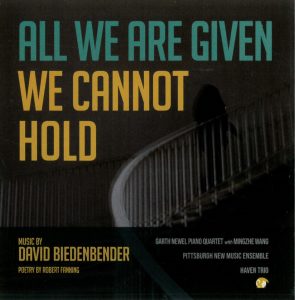 All We Are Given We Cannot Hold. Pittsburgh New Music Ensemble: Kevin Noe, conductor and artistic director; Lindsay Kesselman, soprano; Erika Boysen, flute; Gunnar Owen Hirthe, clarinet and bass clarinet; Nathalie Shaw, violin; Norbert Lewandowski, violoncello; Ian Rosenbaum, vibraphone and glockenspiel; Oscar Micaelsson, piano; Garth Newel Piano Quartet: Teresa Ling, violin; Evelyn Grau, viola; Isaac Melamed, violoncello; Jeannette Fang, piano; with Mingzhe Wang, clarinet; Haven Trio: Lindsay Kesselman, soprano; Kimberly Cole Luevano, clarinet; Midori Koga, piano. D. Biedenbender: Shell and Wing; Red Vesper; all we are given we cannot hold; Solstice. Blue Griffin Recording, BGR649. Total Time: 77:54.
All We Are Given We Cannot Hold. Pittsburgh New Music Ensemble: Kevin Noe, conductor and artistic director; Lindsay Kesselman, soprano; Erika Boysen, flute; Gunnar Owen Hirthe, clarinet and bass clarinet; Nathalie Shaw, violin; Norbert Lewandowski, violoncello; Ian Rosenbaum, vibraphone and glockenspiel; Oscar Micaelsson, piano; Garth Newel Piano Quartet: Teresa Ling, violin; Evelyn Grau, viola; Isaac Melamed, violoncello; Jeannette Fang, piano; with Mingzhe Wang, clarinet; Haven Trio: Lindsay Kesselman, soprano; Kimberly Cole Luevano, clarinet; Midori Koga, piano. D. Biedenbender: Shell and Wing; Red Vesper; all we are given we cannot hold; Solstice. Blue Griffin Recording, BGR649. Total Time: 77:54.
This lovely collection of works by David Biedenbender features several groups and is unified by the composer’s lyrical and poignant music. It is a treat for the listener to be immersed in Biedenbender’s evocative work through the lens of such strong performances on this well-crafted and executed album.
Shell and Wing, recorded by the Pittsburg New Music Ensemble, is based on text by Robert Fanning and beautifully interpreted by soprano Lindsay Kesselman. The group cohesion and strong ensemble intensity matches Biedenbender’s musical portrayal of love, loss, and yearning.
The next piece on the album, Red Vesper, is recorded by the Garth Newel Piano Quartet with Mingzhe Wang, clarinet. Inspired by an evening prayer ritual and the beauty of our national parks, the group matches the dramatic musical setting with a unified and cohesive sound and a strong arc throughout the piece. Wang’s effortless and rich tonal palette is a wonderful part of this profound work, and his mastery of the clarinet is on full display. He blends perfectly with the strings, creating a nuanced and effective soundscape. If there was any slight critique, it would be that the engineers could have let Wang’s warm and inviting tone come through a bit more in the mix.
Biedenbender describes the poetry of Robert Fanning on the track all we are given we cannot hold, as immersed in the art of finding the profound beauty in fleeting everyday moments. On his website he encapsulates the gestalt of the piece in reference to a conversation with a friend:
We were talking about how my children often snuggle up and cuddle with me, and she was reflecting on how her grown child no longer does that when she said, “cherish those moments. They are so special and beautiful, because you won’t realize until later that it was the last time that they did that seemingly small thing.” There are so many moments in life like this, and my hope with this piece is to reflect on their poignant beauty in an attempt to live in them more fully.
The Haven Trio, polished and imaginative, is the perfect group for Biedenbender’s diverse and expressive compositional style. Comprised of Lindsay Kesselman, Kimberly Cole Luevano, and Midori Koga, the group is equally poignant as they are virtuosic. Seamless in their execution and their ensemble work, the group is so unified in sound and technical acumen that they can switch effortlessly between traditional and extended techniques without so much as a ripple in the texture of the music. The amazing musicianship of the players allows the listener to be immersed in Biedenbender’s ethereal music and Fanning’s touching poetry. Luevano’s clarinet playing is as rich in tone as it is deep in interpretation. Her vocal and effortless technique allow the listener to be fully immersed in the musical moment. With impeccable technique and flawless unity of sound, Luevano’s ensemble playing on this album is nothing short of a tour de force.
The album concludes with Solstice, recorded here by the Garth Newell Piano Quartet. The piece evokes the changing of the seasons in the beautiful Allegheny mountains. The performers are obviously comfortable as a group and match each other beautifully in expression and technical elements.
– Stephanie Zelnick
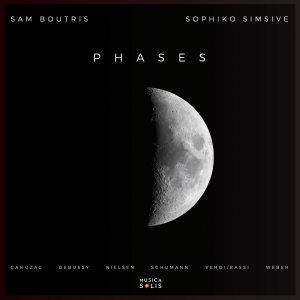 Phases. Sam Boutris, clarinet; Sophiko Simsive, piano. L. Cahuzac: Cantilène; R. Schumann: Three Romances, op. 94; L. Bassi: Fantasy on Themes from Verdi’s “Rigoletto”; C. Debussy/arr. S. Boutris: “Clair de Lune” from Suite Bergamasque, L. 75; C. Nielsen: Fantasy Piece in G minor for clarinet and piano; C.M. von Weber: Andante et Rondo Ungarese, op. 35. Musica Solis, MS202401. Total Time: 47:07.
Phases. Sam Boutris, clarinet; Sophiko Simsive, piano. L. Cahuzac: Cantilène; R. Schumann: Three Romances, op. 94; L. Bassi: Fantasy on Themes from Verdi’s “Rigoletto”; C. Debussy/arr. S. Boutris: “Clair de Lune” from Suite Bergamasque, L. 75; C. Nielsen: Fantasy Piece in G minor for clarinet and piano; C.M. von Weber: Andante et Rondo Ungarese, op. 35. Musica Solis, MS202401. Total Time: 47:07.
Sam Boutris leads a diverse career as concerto soloist, recitalist, and chamber musician while also maintaining a full private studio. His students have earned prizes in the International Clarinet Association student competitions and gone on to attend many prestigious institutions. Boutris is a graduate of the Curtis Institute of Music, Yale School of Music, and The Juilliard School, and a recipient of the “Musica Solis” Grand Prize award at the 2019 Chamber Music Northwest International Clarinet Competition. In Phases, his debut album, Boutris is joined by pianist Sophiko Simsive who is a solo and chamber musician of the highest caliber.
According to the liner notes, “This album pays homage to the composers—but not necessarily to the same compositions—whose gravitational pull drew clarinetist Sam Boutris into distinct phases of his musical development.” The works on this album include many pearls of our literature as well as some less frequently performed pieces such as Claude Debussy’s “Clair de Lune” from Suite Bergamasque (arranged by Boutris) and Carl Nielsen’s Fantasy Piece. These works should be added to our diet to enjoy the subtle nuances of the clarinet.
Boutris and Simsive present an elegantly crafted and engaging performance throughout this album. Boutris’s vocal tone quality, effortless technical mastery, and entrancing musicality are mesmerizing. Simsive is an equally brilliant expressive partner.
Of particular note is the performer’s arrangement of Debussy’s “Clair de Lune.” As stated in the liner notes, “The clarinet’s syrupy sostenuto threads the implied voice leading of the piano’s top line into a true, legato melody.” Boutris and Simsive give a charmingly elegant, entrancing performance. Boutris effortlessly glides through the altissimo register for truly breathtaking moments. This arrangement is like a decadent dessert, and I would personally love to acquire the work for performance consideration.
Phases is a delightful delicacy of music that showcases the vocal quality and suppleness of the clarinet. Boutris plays with an effortlessly lyrical sound and musical dexterity. His performance across this album is an example for all players to bear in mind: take the time to play with a beautiful sound and ensure that every phrase has purpose, character, and care. Highly consider this recording for your listening pleasure and study.
– Julianne Kirk Doyle
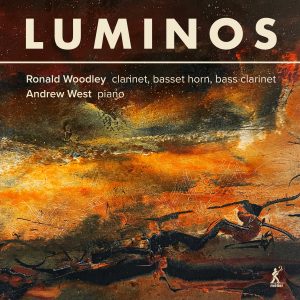 Luminos. Ronald Woodley, clarinet, basset horn, bass clarinet; Andrew West, piano. E. Lutyens: This Green Tide, op. 103 for basset horn and piano; Five Little Pieces, op. 14, no. 1 for clarinet and piano; A.E. Slater: Around the Darkening Sun for bass clarinet and piano; M. Pert: Luminos, op. 16a for basset horn and piano; C. Fox: This has happened before for four multitracked bass clarinets; L.D. Johnson: The Space Between Heaven and Earth for basset horn and piano; E. Cowie: Heather Jean Nocturnes for bass clarinet and piano. Métier, MEX77118. Total Time: 76:40.
Luminos. Ronald Woodley, clarinet, basset horn, bass clarinet; Andrew West, piano. E. Lutyens: This Green Tide, op. 103 for basset horn and piano; Five Little Pieces, op. 14, no. 1 for clarinet and piano; A.E. Slater: Around the Darkening Sun for bass clarinet and piano; M. Pert: Luminos, op. 16a for basset horn and piano; C. Fox: This has happened before for four multitracked bass clarinets; L.D. Johnson: The Space Between Heaven and Earth for basset horn and piano; E. Cowie: Heather Jean Nocturnes for bass clarinet and piano. Métier, MEX77118. Total Time: 76:40.
British clarinetist Ronald Woodley has released an album featuring new music for clarinet, basset horn, and bass clarinet with piano played by Andrew West. Of the seven works included, three are for basset horn and three for bass clarinet. Five are premiere recordings of pieces written for Woodley, and the other two were written for the British basset hornist Georgina Dobrée. As we are beginning to see a resurrection of the basset horn and alto clarinet, it is exciting to find new works for this long-neglected middle voice of the clarinet family!
Elisabeth Lutyens’s This Green Tide, op. 103 (1975) for basset horn and piano opens the album with a soft minor-second two-note motif that Woodley performs in an intriguingly haunting way, immediately drawing the listener in. With the sweet highs and powerful lows, Woodley maintains a broad tone and control throughout the full dynamic range, gliding seamlessly through all the registers of the basset horn.
The second work on the album is the premiere recording of Angela Elizabeth Slater’s Around the Darkening Sun for bass clarinet and piano, written for Woodley in 2020. This five-minute work continues to showcase his ability to soar through the registers of the bass clarinet just as easily as with the basset horn. The piece begins with the bass clarinet and piano playing raucous low notes, followed by more gentle playing as the two parts become entwined. As the work continues, they become more separated and follow their own paths of development before coming back together for the slowly emerging melody of long tones with a final flurry at the end.
The title track, Luminos, op. 16a for basset horn and piano, was written by Morris Pert in 1972. Like the Lutyens, there is an ominous character to the beginning of the piece, with the piano using several extended techniques to set the mood. For the next 16 minutes Woodley takes the listener on a journey with the basset horn, telling a story that begins with a melancholy narrative that gains momentum into a driving persistence in the upper register of the instrument. It relents into a lyrical calmness supported by more piano textures and Woodley’s tender playing shines through here. The form repeats the moods of agitation and somberness, ending with a reflective pensiveness. This is a very enjoyable piece that highlights Woodley’s sensual musicality and technical control of the basset horn.
The only work on the album without piano is Christopher Fox’s This has happened before for four bass clarinets, which Woodley has multitracked. The four bass clarinets play the same slow-moving long-note melodic material, but beginning at different times and at different speeds. The playing itself is minimalist, but its simplicity allows the beautiful harmonic elements created by the differing speeds of the melodic lines to emerge.
Lutyens contributes another piece to the album, for BÌ clarinet and piano, Five Little Pieces, op. 14 no. 1. Written in 1945, this is the premiere recording of the five short movements. Each miniature is under one or two minutes long and titled according to its mood: “Lirico,” “Drammatico,” “Doloroso,” “Pastorale,” and “Declamatorio.” Woodley’s clarinet sound is rich and fluid as he takes command of each expression.
The Space Between Heaven and Earth is the third work for basset horn and piano on the album, and the premiere recording. The four movements are named for the four seasons. “Winter,” as one might imagine, has a bleak mood and, following what seems to be a theme on this album, begins with soft and sparse musical ideas that Woodley conveys with beautiful conviction. “Spring” brings a sense of hope with the basset horn ascending into its altissimo register. “Summer” gives Woodley a chance to show off his agility on the instrument as it bounces through the themes, arriving at “Autumn” with its long basset horn lines and Woodley’s robust tone as West’s piano tinkles away underneath.
The final work and premiere recording on the album is Edward Cowie’s five-movement Heather Jean Nocturnes for bass clarinet and piano, composed in 2023 and based on paintings created by his wife. Woodley’s expressive voice on the bass clarinet shines through in this piece with exemplary blend with the piano. His lyrical mastery is punctuated with dynamic control of the musical material, exploring a rich variety of timbres and occasional contemporary techniques. The result is a wonderful 20-minute tour exploring the nuances of the four-elements-inspired artwork as interpreted through sound. The paintings are printed in the accompanying booklet, which is itself a hefty tome as far as album covers go, at 24 pages with liner notes, biographies, and photographs.
Clocking in at 76 minutes and 40 seconds, the 18 tracks of Luminos just fit onto a single CD, but are also available in downloadable formats. I would recommend this album to anyone that is looking for new works for basset horn and bass clarinet, brought to life by Ronald Woodley’s wonderfully emotive and expressive playing.
– Jason Alder
 Live in Salvador. Duo Campos-Luciano: José Henrique de Campos, guitar; Luca Luciano, clarinet. L. Luciano: Vocalizzo; Contemporary Suite;Piccola Danza Russa; Joaninha. Digital Release. Total Time: 10:45.
Live in Salvador. Duo Campos-Luciano: José Henrique de Campos, guitar; Luca Luciano, clarinet. L. Luciano: Vocalizzo; Contemporary Suite;Piccola Danza Russa; Joaninha. Digital Release. Total Time: 10:45.
This short album showcases compositions by Italian clarinetist Luca Luciano performed by his Duo Campos-Luciano with Brazilian guitarist José Henrique de Campos. A clarinetist of wide-ranging abilities, Luciano is a self-described “solo artist/musician/thinker” (www.lucaluciano.com). Originally from Naples, Luciano is a former clarinet professor at the UK’s Leeds College of Music and has an eclectic resume of performing and teaching in the UK, Europe, and South America. The accomplished clarinet-guitar duo has performed for years in Brazil and Europe, including at Cambridge and Oxford. The idea for this short album of about 11 minutes of music was inspired by Luciano’s trip to Brazil and the week he spent teaching master classes and working with young musicians in NEOJIBA, a leading South American youth orchestra. This album features live recordings of the duo’s performance from the final concert in Salvador, Brazil, in November of 2023.
Luciano’s compositions recorded here include a three-movement Contemporary Suite with a prelude to Stravinsky and two fragments, No. 7 and No. 10. “Fragment No. 7” is the main focus here. It is a work earlier premiered by the duo at Cambridge in 2017 that particularly invokes extended techniques for both clarinet and guitar. Duo Campos-Luciano premiered Vocalizzo, the other piece of “classical” post-modernist music, at Oxford in 2016. The other two selections, Piccola Danza Russa and Joaninha show Campos and Luciano’s interest in popular Brazilian music and improvisation. These two selections sound more complete than the contemporary works and are thoroughly enjoyable! Luciano’s spirited interpretation, assured expression, even technique and sparkly tone really shines here. Luciano’s familiarity and ease in both contemporary and jazz styles is recognizable throughout, but his improvised passages are especially to be admired.
The duo achieves a good blend and balance throughout the live recording which captures the moment. The impetuosity, impulsiveness, and spontaneity so central to Luciano’s trademark performances shines through in this album. The recording quality is excellent and belies the fact that it was recorded live. These short miniatures are disparate pieces that provide a quick exploration into the artistry of a performer who doesn’t subscribe to one particular idiom or one specific mode of expression. The compact, economical forms still reveal Luciano’s distinctive voice and style. While I am more accustomed to full length CD recordings complete with liner notes and jewel case, this listening experience is akin to an appetizer or amuse-bouche for the meal, leaving the listener wanting more!
– Gail Lehto Zugger
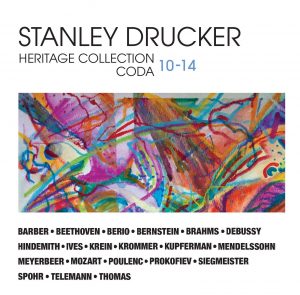 Stanley Drucker Heritage Collection: Coda 10-14. Stanley Drucker, clarinet; with various artists including Naomi Drucker, clarinet. F. Krommer: Selections from Thirteen Pieces, op. 47; Concerto for Two Clarinets and Orchestra in EÌ Major, op. 35; A. Krein: Hebrew Sketches, no. 1, op. 12; L. Bernstein: Sonata; G. Meyerbeer: Hirtenlied; L. Weiner: Ballade, op. 8; L. van Beethoven: Trio in BÌ Major, op. 11; W.A. Mozart: Trio in EÌ Major “Kegelstatt”, K. 498; Clarinet Concerto in A Major, K. 622; C. Ives: Largo; E. Thomas: Concerto; E. Siegmeister: Prelude, Blues, and Finale; Slow Drag; P. Hindemith: Sonata for Clarinet and Piano in BÌ Major; Unknown: Duo for Clarinet and Viola; S. Prokofiev: Overture on Hebrew Themes, op. 34; S. Barber: Summer Music for Wind Quintet, op. 31; F. Mendelssohn: Concert Piece No. 1 in F Minor, op. 113; G.P. Telemann: Concerto for Two Clarinets and Strings in D Minor, TWV 52:D1; L. Spohr: Concerto No. 3 in F Minor, Wo0 19; J. Brahms: Sonata for Clarinet and Piano in EÌ Major, op. 120, no. 2; M. Kupferman: Four Double Features for Two Clarinets; F. Poulenc: Sonata, FP 184 for clarinet and piano; Sonata, FP 7 for two clarinets; C. Debussy: Petite Pièce; S. Perrin, T. Phillips, E. Joffe: Interviews with Stanley Drucker; L. Berio: Sequenza IXa; R. Drucker: Down Here at the Docks. Clover Field Recordings. Total Time: 69:27 [Disc 10]; 76:06 [Disc 11]; 56:55 [Disc 12]; 75:55 [Disc 13]; 46:23 [Disc 14].
Stanley Drucker Heritage Collection: Coda 10-14. Stanley Drucker, clarinet; with various artists including Naomi Drucker, clarinet. F. Krommer: Selections from Thirteen Pieces, op. 47; Concerto for Two Clarinets and Orchestra in EÌ Major, op. 35; A. Krein: Hebrew Sketches, no. 1, op. 12; L. Bernstein: Sonata; G. Meyerbeer: Hirtenlied; L. Weiner: Ballade, op. 8; L. van Beethoven: Trio in BÌ Major, op. 11; W.A. Mozart: Trio in EÌ Major “Kegelstatt”, K. 498; Clarinet Concerto in A Major, K. 622; C. Ives: Largo; E. Thomas: Concerto; E. Siegmeister: Prelude, Blues, and Finale; Slow Drag; P. Hindemith: Sonata for Clarinet and Piano in BÌ Major; Unknown: Duo for Clarinet and Viola; S. Prokofiev: Overture on Hebrew Themes, op. 34; S. Barber: Summer Music for Wind Quintet, op. 31; F. Mendelssohn: Concert Piece No. 1 in F Minor, op. 113; G.P. Telemann: Concerto for Two Clarinets and Strings in D Minor, TWV 52:D1; L. Spohr: Concerto No. 3 in F Minor, Wo0 19; J. Brahms: Sonata for Clarinet and Piano in EÌ Major, op. 120, no. 2; M. Kupferman: Four Double Features for Two Clarinets; F. Poulenc: Sonata, FP 184 for clarinet and piano; Sonata, FP 7 for two clarinets; C. Debussy: Petite Pièce; S. Perrin, T. Phillips, E. Joffe: Interviews with Stanley Drucker; L. Berio: Sequenza IXa; R. Drucker: Down Here at the Docks. Clover Field Recordings. Total Time: 69:27 [Disc 10]; 76:06 [Disc 11]; 56:55 [Disc 12]; 75:55 [Disc 13]; 46:23 [Disc 14].
The much-awaited final installment of Stanley Drucker’s Heritage Collection has recently been released with much excitement. This 14-disc collection brings listeners the best of Drucker from throughout his entire career. The first three sets in the series Live in Concert, From the Vaults, and Hidden Gems were all released in Drucker’s lifetime; this final set titled Coda gives listeners one last set of “new releases” from the legendary Drucker. Jerome Bunke produced the entire Heritage Collection by working together with Drucker to select top performances from hundreds of hours of recordings and then remaster the originals. Drucker released the first series of the Heritage Collection: Live in Concert (1-5) in 2018; the second series From the Vaults (6-7) in 2020; the third series Hidden Gems (8-9) in 2022; and finally, Coda (10-14) in 2024.
The liner notes put together by Joshua R. Mietz are particularly enlightening and offer great insight into the works and performance. There is a noteworthy story included in Bunke’s producer notes where he recalls a visit with Drucker in October of 2022 to work on compiling and selecting the works to include in this final set of discs. The last selection made was to add Spohr’s Concerto No. 3, which also happens to be the earliest recording included on the set. Bunke also mentioned that he was able to pass along the review from The Clarinet in December 2022 for the Heritage Collection: Hidden Gems written by Stephanie Zelnick, in which Drucker’s response was that it was his “best ever.” Sadly, he died two months later.
There are five separate discs included in Heritage Collection: Coda which covers solo, chamber music, and concertos recorded from 1965-2019. The compilation of materials included in this last set of albums showcases the many triumphs of Drucker’s virtuosic playing throughout the entirety of his career. The remastering of all the works, particularly the older recordings, is stunning and all have stellar sound quality. The liner notes contain all of the critical information including when and where something was recorded along with basic information like performers, ensembles, and conductors. A thoughtful addition to the notes includes anecdotes and reflections from the composers and musicians who worked alongside Drucker.
The final disc in the Heritage Collection: Coda, 14, contains 10 different interviews from a variety of sources including podcast discussions with Clarineat and Clarinet Corner as well as post-performance discussions. The earliest interview included is a post-performance discussion of his c. 1965 performance of Spohr’s Concerto No. 3. Listening to this particular interview is exceptional because you get to go back in time and hear young Drucker talking about joining the New York Philharmonic at the age of 19. At that time, he was the youngest member ever admitted to the group. It is astounding to think that he would later receive the Guinness World Record for the longest professional career as a clarinetist where he performed as a member of the New York Philharmonic for an astonishing 62 years, 7 months, and 1 day.
Heritage Collection reflects the best performances and collaborations featuring Drucker, who is one of the true titans in the clarinet world. These recordings ensure that Drucker’s legacy will be celebrated and studied for generations to come.
– Natalie Szabo
NEW RELEASES
 Serenade. Kilian Herold, clarinet; Florian Donderer, violin; Barbara Buntrock, viola; Tanja Tetzlaff, cello. SWR Kultur.
Serenade. Kilian Herold, clarinet; Florian Donderer, violin; Barbara Buntrock, viola; Tanja Tetzlaff, cello. SWR Kultur.

Ebony Chants. Paolo Marchettini, clarinet; Meng Zhang, clarinet; Ka Hei Chan, clarinet; Tommy Shermulis, bass clarinet. New Focus Recordings, FCR402.
 From the Depths. Jonathan Russell, bass clarinet. Musica Solis, MS202406.
From the Depths. Jonathan Russell, bass clarinet. Musica Solis, MS202406.
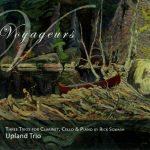 Voyageurs. Upland Trio: Christopher Bade, clarinet; Josh Aerie, cello; Greg Kostraba, piano. Kickshaw Records, 1003.
Voyageurs. Upland Trio: Christopher Bade, clarinet; Josh Aerie, cello; Greg Kostraba, piano. Kickshaw Records, 1003.
 Project Earth: The Blue Chapter. Iris Trio: Christine Carter, clarinet; Zoë Martin-Doike, viola; Anna Petrova, piano. Centrediscs, CMCCD 33924.
Project Earth: The Blue Chapter. Iris Trio: Christine Carter, clarinet; Zoë Martin-Doike, viola; Anna Petrova, piano. Centrediscs, CMCCD 33924.
 Connection. Marek Švejkar, clarinet; Lenka Korecká, piano. Radioservis.
Connection. Marek Švejkar, clarinet; Lenka Korecká, piano. Radioservis.
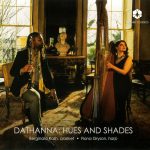 Dathanna: Hues and Shades. Berginald Rash, clarinet; Fiona Gryson, harp. Orchid Classics, ORC 100278.
Dathanna: Hues and Shades. Berginald Rash, clarinet; Fiona Gryson, harp. Orchid Classics, ORC 100278.
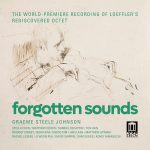 forgotten sounds. Graeme Steele Johnson, clarinet; Stella Chen, violin; Matthew Cohen, viola; Samuel DeCaprio, cello; Yun Han, cello; Bridget Kibbey, harp; Bora Kim, violin; Siwoo Kim, violin; Han Lash, harp; Matthew Lipman, viola; Rachel Loseke, violin; Ji Weon Ryu, flute; David Shifrin, clarinet; Sam Suggs, double bass; Kohei Yamaguchi, double bass. Delos, DE3603.
forgotten sounds. Graeme Steele Johnson, clarinet; Stella Chen, violin; Matthew Cohen, viola; Samuel DeCaprio, cello; Yun Han, cello; Bridget Kibbey, harp; Bora Kim, violin; Siwoo Kim, violin; Han Lash, harp; Matthew Lipman, viola; Rachel Loseke, violin; Ji Weon Ryu, flute; David Shifrin, clarinet; Sam Suggs, double bass; Kohei Yamaguchi, double bass. Delos, DE3603.
Comments are closed.